Dear Friends and Neighbors,
Welcome to Volume 4 of our Field Notes Newsletter – the place for neighbors, community members, Montanans, and anyone curious to get to know us through boots-on-the-ground updates, storytelling, and information. This issue features a look at research happening right here on the prairie, a reflection from our Montana Conservation Corps summer intern, a prairie flora species spotlight on silver buffaloberry, a glimpse into our events for Indigenous Peoples’ Month, and more.
As the fall settles in and winter approaches, the cottonwoods have turned, brown grasses rustle in the prairie wind, bugling elk bachelor up before winter and prairie dogs are burrowing deeper. I’m excited for this season of change and reflection on what has been an incredible year. Take this opportunity to slow down and enjoy learning more about the latest from American Prairie.
Cheers,
Anna Schale
Public Access Coordinator
Research on the Prairie
An Interview with Superintendent Damien Austin
American Prairie offers unparalleled opportunities to conduct scientific research on the grasslands, and every year we see an influx of researchers, interns, project crews, and more to the prairie. As summer comes to a close, most of these folks pack up after a busy and bustling field season. We asked Superintendent Damien Austin to give us a brief glimpse into the science happening on the prairie, and reflect on this season.
Could you give us an overview of scientific partnerships and how research is conducted at American Prairie?
We have many different collaborations going on, but our main science partner is Smithsonian’s National Zoo and Conservation Biology Institute (NZCBI). We’ve got three principal investigators (PI’s) with the Smithsonian that are out on the ground. Those PI’s bring a whole bunch of other resources with them, including grad students, technicians, and other visiting researchers. Beyond that partnership, we’ve developed relationships with other universities and hosted graduate students from the University of Montana, Montana State University, Clemson University, and many other professional institutions. Scientists and researchers often ask for permission to come to the prairie to collect soil samples, look for archaeological evidence, or any number of reasons to advance their research.
What are some of the interesting projects happening out there right now or this summer?
I think the prairie dog collaring project is really neat. The principal investigator on this is Dr. Hila Shamon with the Smithsonian. Her team is putting collars on prairie dogs and using the movement data collected by the collars to attempt to map the interior burrows of prairie dog towns. By detecting the small movements made by prairie dogs as they navigate through the tunnels, researchers are hoping to create a 3-D rendering of what the town looks like below ground. This work is experimental. Previously, researchers tried to use ground-penetrating radar to map out the burrows, but because of the high iron content of the soils in prairie dog colonies, the radar couldn’t penetrate deep enough to show pictures of what the burrow structures look like.
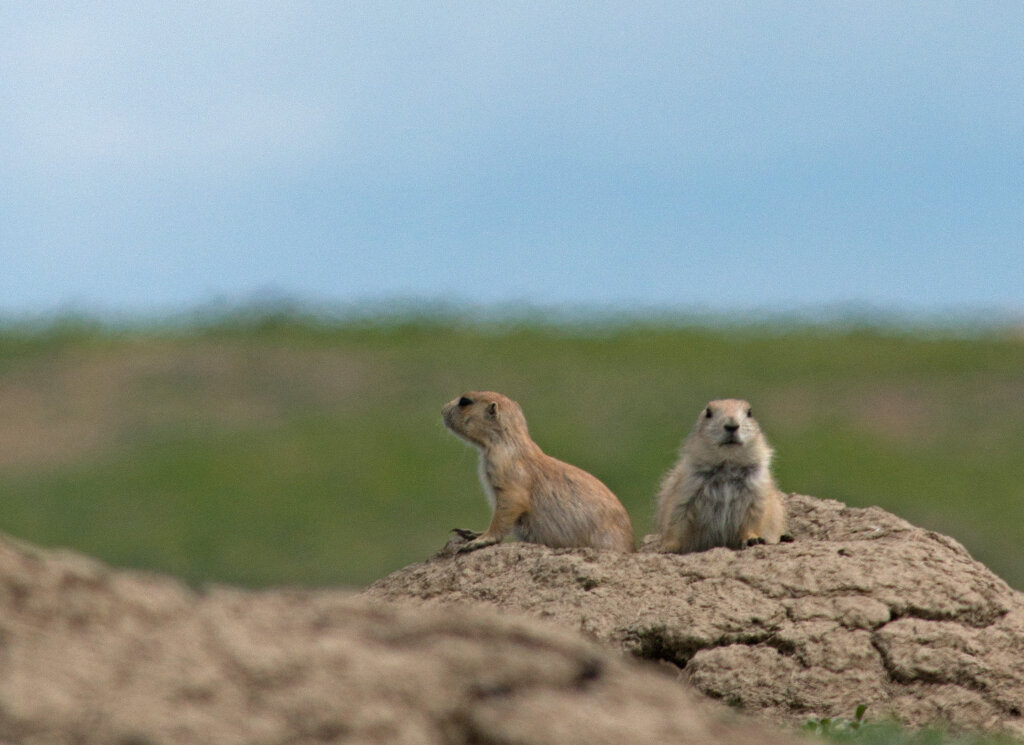
Another great project happening involves Telegraph Creek on the Sun Prairie Property. Last year we worked with a contractor to evaluate the riparian health of parts of the creek, and this year we hired another contractor to help us design and implement artificial beaver dam analogs (BDA’s). For installation of those analogs, we turned to the Montana Conservation Corps. This project has been a couple years in the making, but by the end of this season we’ll have gone from gathering our first bit of baseline data, to implementing that plan to increase the functionality of a large portion of Telegraph Creek. Once we get those structures in place, we will monitor their effectiveness and track the riparian health improvements of the creek.

What you do you think is the most important impact of research on the prairie?
Each piece of scientific research on the prairie helps us better understand how this diverse grassland ecosystem works – what parts are functioning properly and what parts need help. It’s a slow progression as science advances over the years, but we learn more and more every single year. It’s exciting to think that the questions we’re asking right now will be answered in the future, and the ones we were asking years ago are being answered right now.
Damien Austin
Vice President & Superintendent
Meet our Summer Intern
Allison Blahitka
My name is Allison Blahitka! I am from Allen, TX, and I am a rising senior at Texas A&M University studying wildlife management. This summer, I was a conservation intern with Montana Conservation Corps and my host site was American Prairie. I have grown up going to Wyoming with my family, but this was my first time being in Montana and I am so thankful it was in Lewistown with American Prairie.
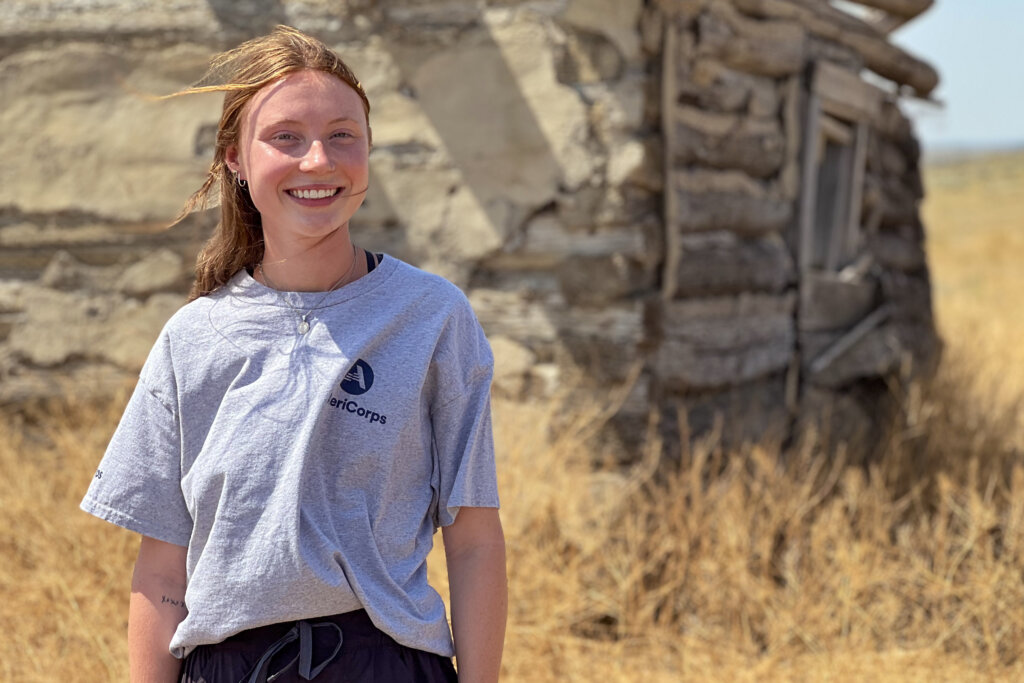
My main project for the summer was recording historical sites on American Prairie’s properties. I spent many days in the field, searching for sites like homesteads, old buildings, old agriculture equipment, headstones, etc. I was also able to speak to people in the community who had family ties to these places and knowledge about their history. I am so grateful for their help and insight.
One of my favorite memories out on the prairie was driving the loop on the Blue Ridge property. The road was rugged and I wasn’t sure how far I was going to get, but I made it to the top of an overlook and I was in awe. I looked across the prairie for miles and miles. I sat there taking in the astonishing view, thinking about how thankful I was to be there.
On the days I was not in the field, I was working at the front desk of the National Discovery Center. Those days were so rewarding. I was able to meet many amazing people and have many interesting conversations. I loved getting to hear about the unforgettable trips people have made to the prairie. This experience has made me so excited for my future in conservation! I am so thankful for the American Prairie staff and all the incredible people I was able to meet in this community. I am going to miss Lewistown so much. I hope to be back, but in the winter the next time around!
American Prairie Gives Back
American Prairie is proud to support the communities and people where we live and work.
Here are some highlights from 2023.
-
- More than 30 staff from Bozeman, Lewistown, and Phillips County volunteered with the Lewistown Boys and Girls Club to work on a remodel project.
- Partnering with friends from the Aaniiih Nakoda Community at Fort Belknap, we provided our Antelope Creek Campground as a host site for a group of 18 US Marine Veterans and their families to come together for a week of connection and healing, including sweat lodge ceremonies and a traditional buffalo hunt at Fort Belknap.
- We provided 18 unique bison harvest opportunities to Montanans in our public drawing, and donated additional opportunities for local charities including the Central Montana Hospital Foundation, Crooked Creek Walleyes Unlimited, and Central Montana Search and Rescue.
- Our team worked with Backcountry Hunters and Anglers’ Armed Forces Initiative to provide a once-in-lifetime elk hunt opportunity on our Blue Ridge Property for a veteran.
- Thousands of pounds of bison meat went into our local food banks, the Montana Food Bank Network, and other charities and groups.
- We sponsored and attended community events, including CenterFest, Hot Summer Nights, the Gathering of Families, and many more.
As always, reach out to Senior Outreach Manager Corrie Williamson with inquiries about sponsorship and community support.
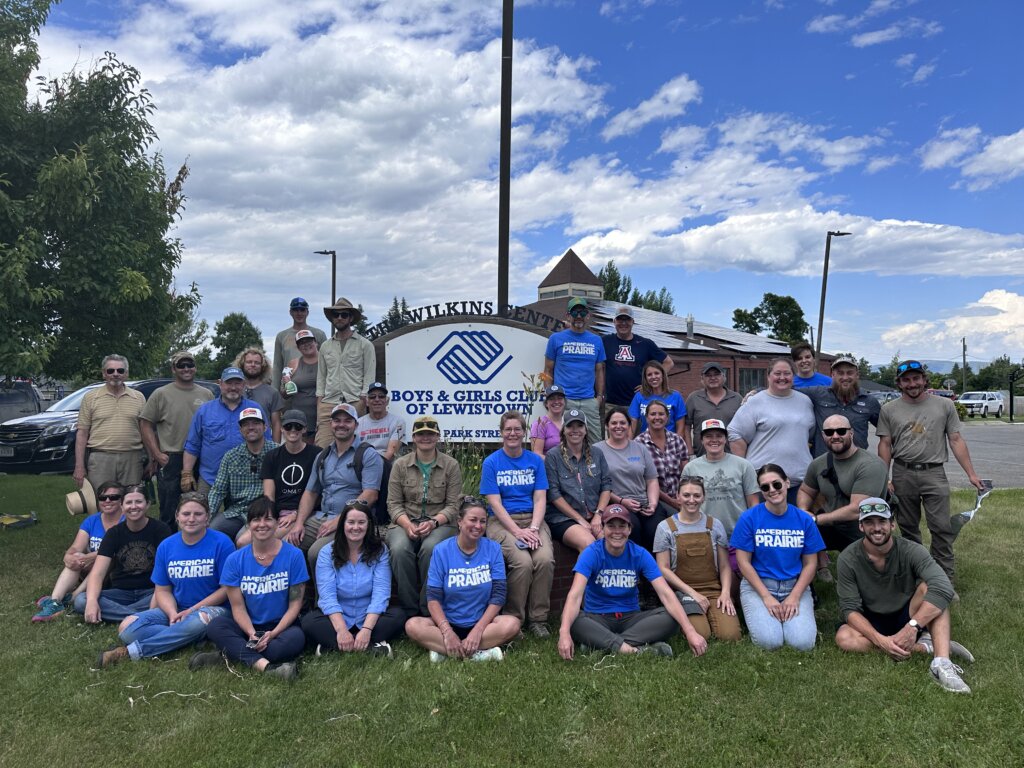
Celebrating Indigenous Peoples’ Day
This year, Indigenous Peoples’ Day falls on October 9. We are honored to work with our Indigenous neighbors across many partnerships, from bison restoration to educational programming and the sharing and preservation of cultural heritage. We will celebrate the holiday with special events at the NDC. Join us on October 10 for archaeologist Carl Davis’ talk “600 Generations: Exploring the Indigenous Archaeology of Montana.”
From October 1 through December 31, we will host the Nez Perce (Nee-Me-Poo) National Historic Trail (NPNHT) pop-up display, “The Journey of the Resilient Niimiipuu People” from the Ravalli County Museum & Historical Society. The small but powerful traveling exhibit immerses visitors in the history and culture of the Nez Perce people, including the Trail. Stop by and check it out Thursday – Saturday, 10 am – 4 pm.
Visit us online for more information on these and all other National Discovery Center events and exhibits.
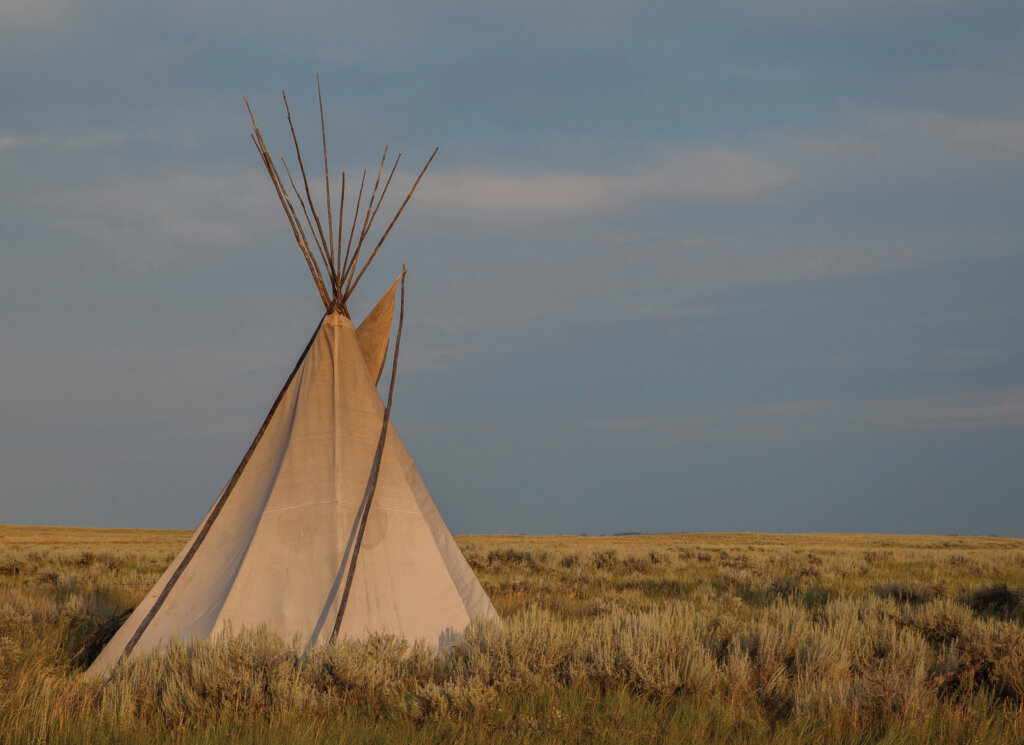
Species Spotlight
Silver Buffaloberry
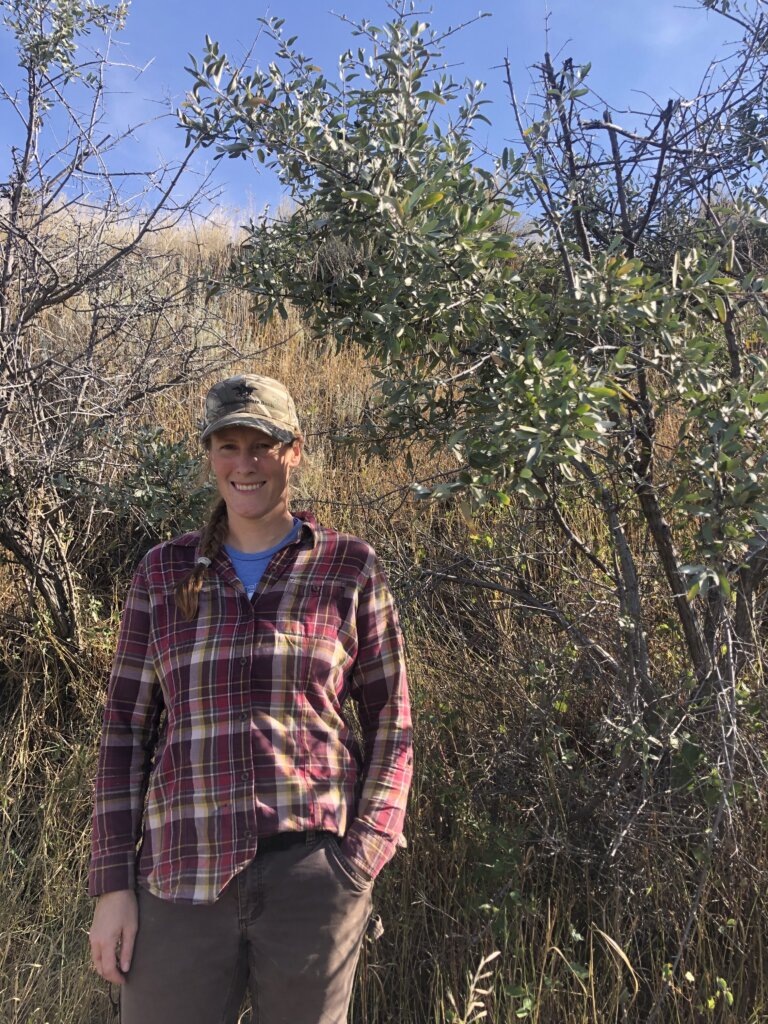
After our last issue, we had a request to highlight a prairie species. We asked Program Manager and plant expert, Ellen Anderson, to share some information about a favorite prairie flora. Ellen lives with her family on the White Rock property in south Phillips County, where she works on habitat restoration.
Silver buffaloberry (Shepherdia argentea)
There are three species of buffaloberry, all native to North America. Silver buffaloberry is a native shrub found in all western states and the northern Great Plains. It grows along streams, coulees, and wet hillsides. A deciduous shrub that can grow up to 12 feet tall, it likes full sunlight and can tolerate alkaline soils. It is a nitrogen fixing plant, which allows it to tolerate poor soil conditions.
Other plant species found with silver buffaloberry include chokecherry, green ash, and boxelder trees. These vegetation communities are fairly tolerant of fire, especially when in their dormant states. After a fire, silver buffaloberry will resprout from its root crown.
The branches are light colored and thorny. The leaves are a silvery green color which gives it a similar appearance to Russian olive. The two plants are related, but Russian olive is a non-native tree common to the northern Great Plains. The best way to distinguish between the two is leaf arrangement. Russian olive has alternative leaves, while buffaloberry has opposite leaves. Silver buffaloberry has male and female plants and both are needed for the summer fruit to be produced. The shrub produces small yellow flowers in the spring, which ripen into a bright red fruit.
Although it is called buffaloberry, it is actually a stone fruit rather than a berry. The fruit is edible to both animals and humans. It is quite tart, but becomes sweeter after the first frost. The thorns of the shrub make it difficult to pick, so shaking the shrub can be the best way.
The shrub is considered of low value as livestock forage, but silver buffaloberry provides important habitat and food for wildlife. In spring, birds use the thickets formed by the shrubs for nesting habitat and cover. The fruits are eaten by animals and birds throughout the fall and winter and the leaves are browsed by deer during the winter.
Silver buffaloberry fruits contain a substance called saponin. The saponin in the fruit is thought to cause the bitter taste of the fruit and can create a soapy foam when the berries are beaten with water. Cooking the fruits breaks down the saponin and they can then be used to make jams, jellies, pies, and to flavor beverages. The fruits are said to have high and diverse levels of vitamins, minerals, and essential fatty acids. They are used to help treat chronic health issues such as diabetes, constipation, arthritis, gallstones, and headaches.
Ellen Anderson
Program Manager
Understanding Public Access on American Prairie
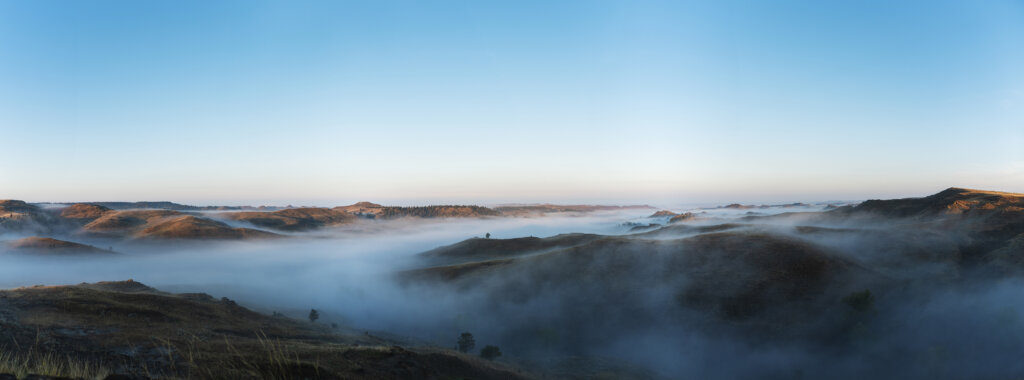
Montana’s population is growing. As more folks are vying for their own little slice of Montana dirt, more and more ‘NO TRESPASSING’ signs are going up, and crowding on public land seems to increase every year. Public access is a key pillar of our mission at American Prairie, and the following breakdown is to help you better understand how to access American Prairie land.
We are working to connect 3.2 million acres of land with the goals of conserving intact habitat, piecing together seamless migration corridors, growing robust wildlife populations, and offering more public access. The total number includes the 1.1-million-acre Charles M. Russell National Wildlife Refuge and hundreds of thousands of acres of existing public land. We currently manage a little more than 460,000 acres of land to date. 340,000 acres are leased Bureau of Land Management and state lands which the public could always enjoy, but in many locations are now able to access more easily via our deeded land.
Of the remaining 124,000 acres of deeded land, more than 82,000 acres – or roughly 65% – are enrolled in Montana’s Block Management program in either Type 1, a sign-in box at the gate, or Type 2, where hunters call for permission. Whether you hunt, hike, camp, birdwatch, or do a little bit of everything, American Prairie is open for access. The remaining 35% consists of our active bison pastures, safety areas around where our field staff live, and the Blue Ridge Special Management Area–where we conduct a free special drawing open to all hunters who have drawn a 620-20, 620-21, 622-20, or 699-01 permit.
All recreationists are encouraged to visit American Prairie to enjoy or to cross our deeded property to access public land. To learn more about hunting, recreating, and accessing land via American Prairie, stop into our National Discovery Center or visit our trip planner online.
Paul Kemper
Marketing Manager
Did You Know?
American Prairie is hosting three artists in residence in 2023!
We are so pleased to partner with OpenAIR, a place-based Artist-in-Residence program that connects artists from all disciplines and origins, with culturally, historically, and ecologically significant locations through collaborative partnerships in Montana. In October 2023, we look forward to hosting Melissa Kwasny, Brandon Reintjes, and Delia Touché on the PN and the Sun Prairie properties. They will return in 2024 to spend more time on the prairie, and host community talks and workshops.
Delia Touché (b. 1994, Devils Lake ND) is based in the Midwest and has exhibited in the United States at venues such as M Contemporary Art (Ferndale, MI), Plains Art Museum (Fargo, ND), and The Art Galleries at Austin Community College (Austin, TX), among others. Delia has work in the permanent art collection of the University of North Dakota. She holds a BFA from Minnesota State University Moorhead and an MFA in Print media from Cranbrook Academy of Art, where she received the Gilbert Fellowship.
Melissa Kwasny is the author of seven books of poetry, an essay collection, and one book of non-fiction. She was Montana Poet Laureate from 2019-2021, a position she shared with M.L. Smoker. She is widely published in journals and anthologies, and is the recipient of numerous awards and residencies. She holds an MFA in Poetry and an MA in Literature from the University of Montana. She has taught poetry as a visiting writer at both the undergraduate and graduate level, including the University of Montana. She lives in southwestern Montana.
Brandon Reintjes was born in Bozeman, Montana, and grew up in Northern Michigan. He received a BFA in fine arts from the School of the Art Institute of Chicago and an MA in curatorial and critical studies from the University of Louisville. He works as senior curator at the Missoula Art Museum and spends the majority of his time thinking about, looking at, and making art. He has exhibited at the Zootown Arts Community Center and the Brink Gallery in Missoula, MT; Luminary Arts Center in St. Louis, MO, the 930 in Louisville, KY, Turman Larison Contemporary in Helena, Aunt Dofe’s Hall of Recent Memory in Willow Creek, MT; with exhibitions in 2023 planned for Aunt Dofe’s Gallery and Northcutt Steele Gallery in Billings, MT.
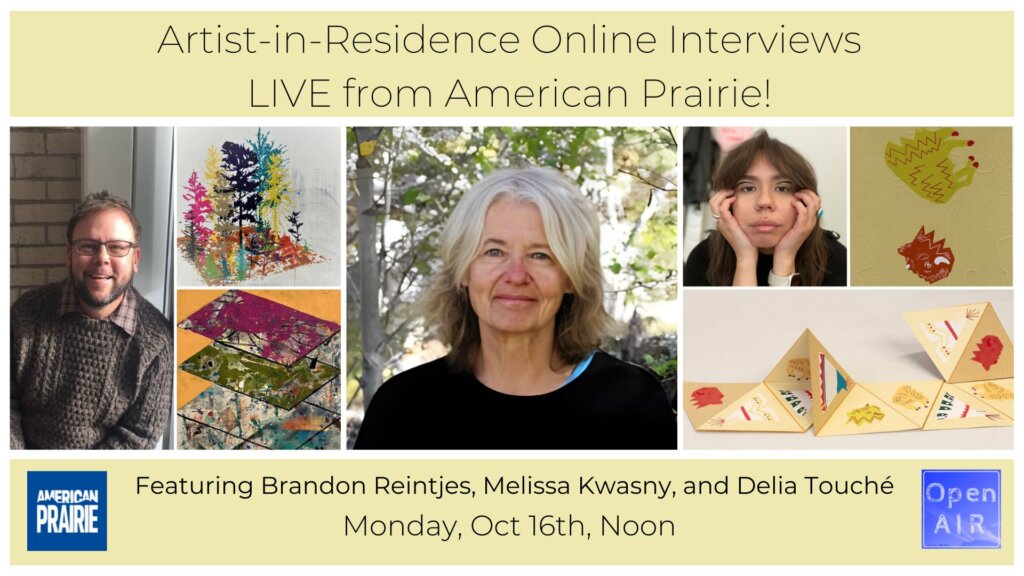
Want to view this newsletter as a PDF? We’ve got you covered in our Field Notes Archive!
